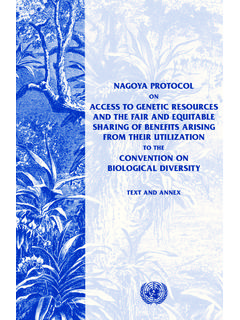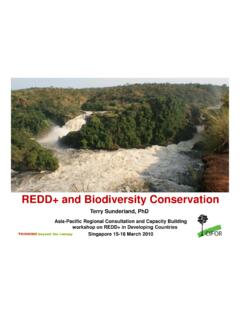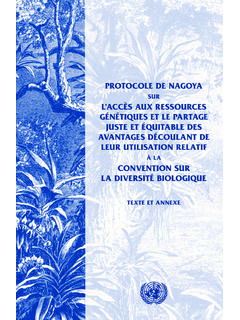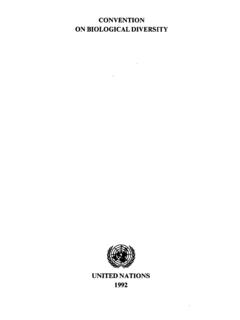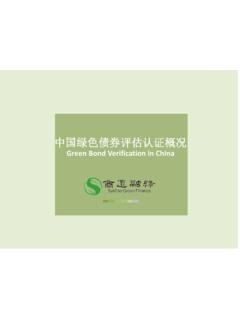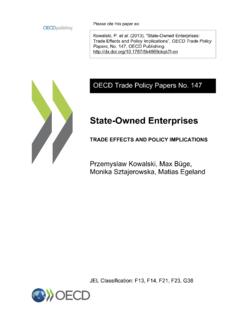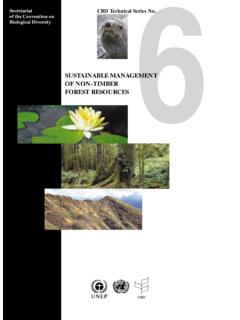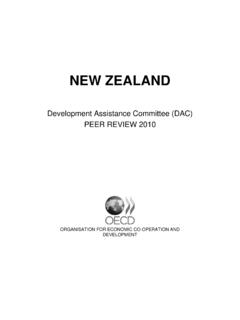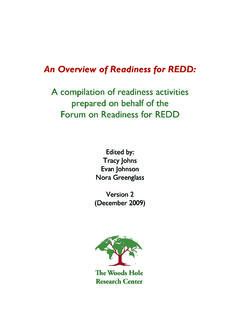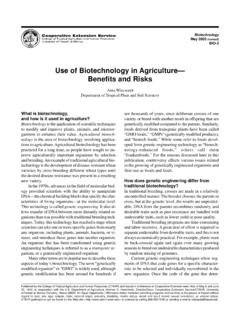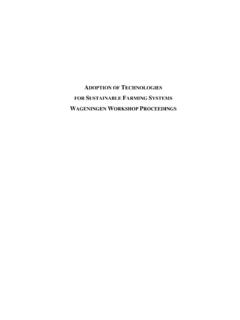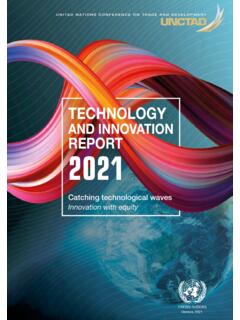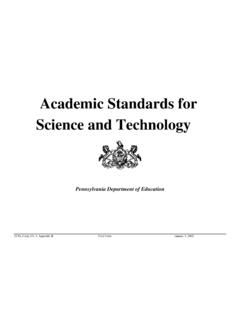Transcription of CARTAGENA PROTOCOL ON BIOSAFETY TO THE …
1 CARTAGENAPROTOCOL ONBIOSAFETY TO THECONVENTION ON BIOLOGICALDIVERSITYTEXT AND ANNEXESP roto/ang 11/13/2000 3:39 PM Page 181 CARTAGENA PROTOCOL ONBIOSAFETY TO THECONVENTION ON BIOLOGICAL DIVERSITYTEXT AND ANNEXESC artagena PROTOCOL on BiosafetyMontreal, 2000 Proto/ang 11/13/2000 3:39 PM Page 182 IntroductionThe Convention on Biological Diversity was finalized in Nairobi in May 1992 and opened for signature at the United Nations Conference on Environment andDevelopment (UNCED) in Rio de Janeiro on 5 June1992. It entered into force on 29 December 1993.
2 Today, the Convention is the main international instrumentfor addressing biodiversity issues. It provides a comprehensive and holisticapproach to the conservation of biological diversity, the sustainable use of naturalresources and the fair and equitable sharing of benefits deriving from the use ofgenetic is one of the issues addressed by the Convention. This concept refers tothe need to protect human health and the environment from the possible adverseeffects of the products of modern biotechnology . At the same time, modernbiotechnology is recognized as having a great potential for the promotion ofhuman well-being, particularly in meeting critical needs for food, agriculture andhealth care.
3 The Convention clearly recognizes these twin aspects of modernbiotechnology. On the one hand, it provides for the access to and transfer oftechnologies, including biotechnology , that are relevant to the conservation andsustainable use of biological diversity (for example, in Article 16, paragragh 1,and Article 19, paragraphs 1 and 2). On the other hand, Articles 8(g) and 19,paragraph 3, seek to ensure the development of appropriate procedures to enhancethe safety of biotechnology in the context of the Convention s overall goal ofreducing all potential threats to biological diversity, taking also into account therisks to human health.
4 Article 8(g) deals with measures that Parties should take atnational level, while Article 19, paragraph 3, sets the stage for the development ofan international legally binding instrument to address the issue of its second meeting, held in November 1995, the Conference of the Parties to theConvention established an Open-ended Ad Hoc Working Group on BIOSAFETY todevelop a draft PROTOCOL on BIOSAFETY , focusing specifically on transboundarymovement of any living modified organism resulting from modern biotechnologythat may have adverse effect on the conservation and sustainable use of biologicaldiversity.
5 After several years of negotiations, the PROTOCOL , known as the CartagenaProtocol on BIOSAFETY to the Convention on Biological Diversity, was finalized andadopted in Montreal on 29 January 2000 at an extraordinary meeting of theConference of the conclusion of the BIOSAFETY PROTOCOL has been hailed as a significant stepforward in that it provides an international regulatory framework to reconcile therespective needs of trade and environmental protection with respect to a rapidlygrowing global industry, the biotechnology industry.
6 The PROTOCOL thus creates an enabling environment for the environmentally sound application ofbiotechnology, making it possible to derive maximum benefit from the potentialthat biotechnology has to offer, while minimizing the possible risks to theenvironment and to human health. 1 CARTAGENA PROTOCOL on BiosafetyMontreal, 2000 Copyright 2000, Secretariat of the Convention on Biological DiversityISBN: 92-807-1924-6 This publication may be reproduced for educational or non-profit purposes withoutspecial permission from the copyright holders, provided acknowledgement of thesource is made.
7 The Secretariat of the Convention would appreciate receiving acopy of any publications that uses this publication as a bibliographic and reference purpose this publication should be referred to as:Secretariat of the Convention on Biological Diversity (2000). CARTAGENA PROTOCOL onBiosafety to the Convention on Biological Diversity: text and annexes. Montreal:Secretariat of the Convention on Biological booklet contains the text of the CARTAGENA PROTOCOL on BIOSAFETY to theConvention on Biological Diversity, which starts on page by the Secretariat of the Convention on Biological DiversityFor further information, please contact:The Secretariat of the Convention on Biological Diversity World Trade Centre393 St.
8 Jacques, Suite 300 Montreal, Quebec, H2Y 1N9 Canada Phone :1 (514) 288 2220 Fax:1 (514) 288 on recycled paperCartagena PROTOCOL on BiosafetyProto/ang 11/13/2000 3:39 PM Page 184 CARTAGENA PROTOCOL ON BIOSAFETY TO THECONVENTION ON BIOLOGICAL DIVERSITYThe Parties to this PROTOCOL ,BeingParties to the Convention on Biological Diversity, hereinafter referredto as the Convention ,RecallingArticle 19, paragraphs 3 and 4, and Articles 8 (g) and 17 of theConvention,Recallingalso decision II/5 of 17 November 1995 of the Conference of theParties to the Convention to develop a PROTOCOL on BIOSAFETY , specificallyfocusing on transboundary movement of any living modified organismresulting from modern biotechnology that may have adverse effect on theconservation and sustainable use of biological diversity, setting out forconsideration, in particular, appropriate procedures for advance informedagreement.
9 Reaffirmingthe precautionary approach contained in Principle 15 of the RioDeclaration on Environment and Development,Aware ofthe rapid expansion of modern biotechnology and the growingpublic concern over its potential adverse effects on biological diversity, takingalso into account risks to human health,Recognizingthat modern biotechnology has great potential for human well-being if developed and used with adequate safety measures for the environmentand human health,Recognizing alsothe crucial importance to humankind of centres of originand centres of genetic diversity,Taking into accountthe limited capabilities of many countries, particularlydeveloping countries, to cope with the nature and scale of known and potentialrisks associated with living modified organisms,Recognizingthat trade and environment agreements should be mutuallysupportive with a view to achieving sustainable development.
10 Emphasizingthat this PROTOCOL shall not be interpreted as implying a changein the rights and obligations of a Party under any existing internationalagreements,Understandingtha t the above recital is not intended to subordinate thisProtocol to other international agreements,Have agreed as follows:Article1 OBJECTIVEIn accordance with the precautionary approach contained in Principle 15 ofthe Rio Declaration on Environment and Development, the objective of thisProtocol is to contribute to ensuring an adequate level of protection in the fieldof the safe transfer, handling and use of living modified organisms resultingfrom modern biotechnology that may have adverse effects on the conservationand sustainable use of biological diversity, taking also into account risks tohuman health.

